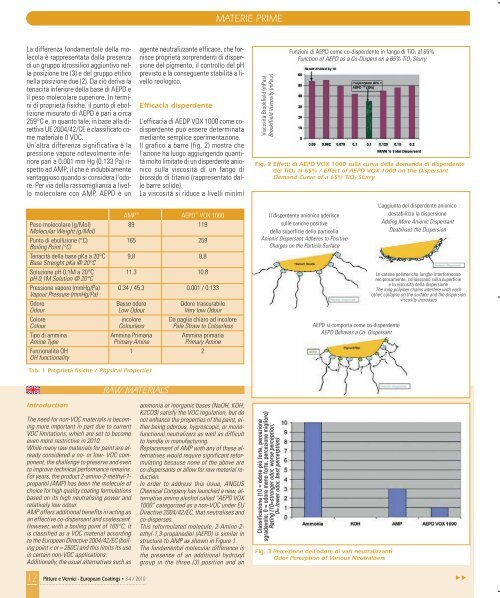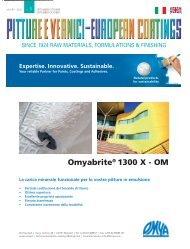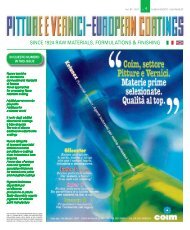You also want an ePaper? Increase the reach of your titles
YUMPU automatically turns print PDFs into web optimized ePapers that Google loves.
La differenza fondamentale della molecola<br />
è rappresentata dalla presenza<br />
di un gruppo idrossilico aggiuntivo nella<br />
posizione tre (3) e del gruppo etilico<br />
nella posizione due (2). Da ciò deriva la<br />
tenacità inferiore della base di AEPD e<br />
il peso molecolare superiore. In termini<br />
di proprietà fisiche, il punto di ebollizione<br />
misurato di AEPD è pari a circa<br />
259°C e, in quanto tale, in base alla direttiva<br />
UE 2004/42/CE è classificato come<br />
materiale 0 VOC.<br />
Un’altra differenza significativa è la<br />
pressione vapore notevolmente inferiore<br />
pari a 0.001 mm Hg (0.133 Pa) rispetto<br />
ad AMP; il che è indubbiamente<br />
vantaggioso quando si considera l’odore.<br />
Per via della rassomiglianza a livello<br />
molecolare con AMP, AEPD è un<br />
Introduction<br />
The need for non-VOC materials is becoming<br />
more important in part due to current<br />
VOC limitations, which are set to become<br />
even more restrictive in <strong>2010</strong>.<br />
While many raw materials for paint are already<br />
considered a no- or low- VOC component,<br />
the challenge to preserve and even<br />
to improve technical performance remains.<br />
For years, the product 2-amino-2-methyl-1propanol<br />
(AMP) has been the molecule of<br />
choice for high quality coating formulations<br />
based on its high neutralising power and<br />
relatively low odour.<br />
AMP offers additional benefits in acting as<br />
an effective co-dispersant and coalescent.<br />
However, with a boiling point of 165°C, it<br />
is classified as a VOC material according<br />
to the European Directive 2004/42/EC (boiling<br />
point < or = 250C) and this limits its use<br />
in certain non-VOC applications.<br />
Additionally, the usual alternatives such as<br />
agente neutralizzante efficace, che fornisce<br />
proprietà sorprendenti di dispersione<br />
del pigmento, il controllo del pH<br />
previsto e la conseguente stabilità a livello<br />
reologico.<br />
Efficacia disperdente<br />
L’efficacia di AEDP VOX 1000 come codisperdente<br />
può essere determinata<br />
mediante semplice sperimentazione.<br />
Il grafico a barre (fig. 2) mostra che<br />
l’azione ha luogo aggiungendo quantità<br />
molto limitate di un disperdente anionico<br />
sulla viscosità di un fango di<br />
biossido di titanio (rappresentato dalle<br />
barre solide).<br />
La viscosità si riduce a livelli minimi<br />
AMP TM<br />
AEPD TM<br />
VOX 1000<br />
Peso molecolare (g/Mol)<br />
Molecular Weight (g/Mol)<br />
89 119<br />
Punto di ebollizione (°C)<br />
Boiling Point (°C)<br />
165 259<br />
Tenacità della base pKa a 20°C<br />
Base Strenght pKa @ 20°C<br />
9,8 8,8<br />
Soluzione pH 0.1M a 20°C<br />
pH 0,1M Solution @ 20°C<br />
11.3 10.8<br />
Pressione vapore (mmHg/Pa)<br />
Vapour Pressure (mmHg/Pa)<br />
0.34 / 45.3 0.001 / 0.133<br />
Odore Basso odore Odore trascurabile<br />
Odour Low Odour Very low Odour<br />
Colore incolore Da paglia chiaro ad incolore<br />
Colour Colourless Pale Straw to Colourless<br />
Tipo di ammina Ammina Primaria Ammina primaria<br />
Amine Type Primary Amine Primary Amine<br />
Funzionalità OH<br />
OH functionality<br />
1 2<br />
Tab. 1 Proprietà fisiche / Physical Properties<br />
RAW MATERIALS<br />
ammonia or inorganic bases (NaOH, KOH,<br />
K2CO3) satisfy the VOC regulation, but do<br />
not enhance the properties of the paint, either<br />
being odorous, hygroscopic, or monofunctional<br />
neutralizers as well as difficult<br />
to handle in manufacturing.<br />
Replacement of AMP with any of these alternatives<br />
would require significant reformulating<br />
because none of the above are<br />
co-dispersants or allow for raw material reduction.<br />
In order to address this issue, ANGUS<br />
Chemical Company has launched a new, alternative<br />
amino alcohol called “AEPD VOX<br />
1000” categorized as a non-VOC under EU<br />
Directive 2004/42/EC, that neutralises and<br />
co-disperses.<br />
This reformulated molecule, 2-Amino-2ethyl-1,3-propanediol<br />
(AEPD) is similar in<br />
structure to AMP as shown in Figu re 1.<br />
The fundamental molecular difference is<br />
the presence of an additional hydroxyl<br />
group in the three (3) position and an<br />
MATERIE PRIME<br />
Fig. 2 Effetti di AEPD VOX 1000 sulla curva della domanda di disperdente<br />
del TiO2 al 65% / Effect of AEPD VOX 1000 on the Dispersant<br />
Demand Curve of a 65% TiO2 Slurry<br />
Classificazione (10 = odore più forte, percezione<br />
sgradevole; 0 = odore meno forte, percezione migliore)<br />
Rating (10=stronger odor, worse perception;<br />
0= lower odor, best percetption)<br />
Funzioni di AEPD come co-disperdente in fango di TiO2 al 65%<br />
Function of AEPD as a Co-Dispers on a 65% TiO2 Slurry<br />
Fig. 3 Percezione dell’odore di vari neutralizzanti<br />
Odor Perception of Various Neutralisers<br />
12 Pitture e Vernici - European Coatings • 3-4 / <strong>2010</strong><br />
▼<br />
▼<br />
Viscosità Brookfield (mPas)<br />
Brookffield Viscosity (mPa.s)<br />
Il disperdente anionico aderisce<br />
sulle cariche positive<br />
della superficie della particella<br />
Anionic Dispersant Adheres to Positive<br />
Charges on the Particle Surface<br />
AEPD si comporta come co-disperdente<br />
AEPD Behaves a Co- Dispersant<br />
L’aggiunta del disperdente anionico<br />
destabilizza la dispersione<br />
Adding More Anionic Dispersant<br />
Deabilises the Dispersion<br />
Le catene polimeriche lunghe interferiscono<br />
reciprocamente, collasssano sulla superficie<br />
e la viscosità della dispersione<br />
The long polymer chains interfere with each<br />
other, collapse on the surface and the dispersion<br />
viscosity increases













